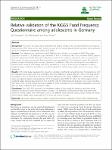Relative validation of the KiGGS Food Frequency Questionnaire among adolescents in Germany
Truthmann, Julia
Mensink, Gert
Richter, Almut
Background: The aim of this study was to determine the relative validity of the self-administered Food Frequency Questionnaire (FFQ) “What do you eat?”, which was used in the German National Health Interview and Examination Survey for Children and Adolescents (KiGGS 2003-2006). Methods: The validation was conducted in the EsKiMo Nutrition Module, a subsample of KiGGS. The study population included 1,213 adolescents aged between 12 and 17. A modified diet history interview DISHES (Dietary Interview Software for Health Examination Studies) was used as the reference method. In order to compare the food groups, the data assessed with both instruments were aggregated to 40 similar food groups. The statistical analysis included calculating and comparing Spearman’s correlation coefficients, calculating the mean difference between both methods, and ranking participants (quartiles) according to food group consumption, including weighted kappa coefficients. Correlations were also evaluated for relative body weight and socioeconomic status subgroups. Results: In the total study population the Spearman correlation coefficients ranged from 0.22 for pasta/rice to 0.69 for margarine; most values were 0.50 and higher. The mean difference ranged between 1.4% for milk and 100.3% for pasta/rice. The 2.5 percentiles and 97.5 percentiles indicated a wide range of differences. Classifications in the same and adjacent quartile varied between 70.1% for pasta/rice and 90.8% for coffee. For most groups, Cohen’s weighted kappa showed values between 0.21 and 0.60. Only for white bread and pasta/rice were values less than 0.20. Most of the 40 food groups showed acceptable to good correlations in all investigated subgroups concerning age, sex, body weight and socio-economic status. Conclusions: The KiGGS FFQ showed fair to moderate ranking validity except for pasta/rice and white bread. However, the ability to assess absolute intakes is limited. The correlation coefficients for most food items were similar for normal weight and overweight as well as for different socio-economic status groups. Overall, the results of the relative validity were comparable to FFQs from the current literature.
Dateien zu dieser Publikation
Keine Lizenzangabe

